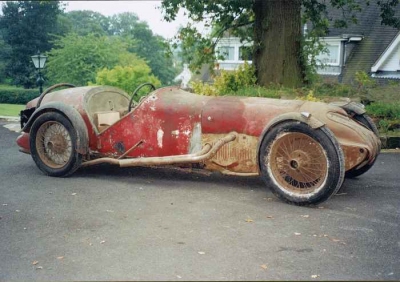SCM Analysis
Detailing
| Vehicle: | 1926 Goodall Sports Special |
| Years Produced: | About 1926 |
| Number Produced: | 1 (?) |
| Original List Price: | Homebuilt |
| Tune Up Cost: | $200 |
| Distributor Caps: | Who knows? |
| Chassis Number Location: | Equally unknown |
| Engine Number Location: | Stamped on it, maybe |
| Club Info: | Vintage Sports Car Club, The Old Post Office, West Street, Chipping Norton, Oxfordshire OX7 5EL |
| Website: | http://www.vscc.co.uk |
| Investment Grade: | C |
This Goodall Special sold for $11,140 at the H&H Buxton, England, auction November 22, 2005.
While each great industrial country has had its share of visionary dreamers-those with the creativity, purpose, and relentless drive to single-handedly mold the future and create history-the British also have a tradition of lesser visionaries who put immense time and resources into projects that are just plain silly. Far from a cultural shortcoming, this arguably demonstrates the depth and richness of a society. It has given us Monty Python, Wallace and Gromit, and countless weird automotive specials.
The Goodall appears to be a classic example of the “pre-war English special.” It was clearly created a very long time ago by someone with a lot of time, a moderate amount of ability, little money, and a good sense of humor.
Many of the specials of the era were cut down, lightened, “hot-rod” variants on existing mechanical packages-Rileys were particularly popular for this. Some were extraordinarily successful in obscure competitions like hill climbs-John Bolster’s twin-engine special “Bloody Mary” and Basil Davenport’s homemade 2-liter V-twin “Spider,” for example. But this car appears to have been assembled literally from junkyard parts in the late ’20s.
I have no personal knowledge of the Goodall Special, only the catalog description, but the Talbot 12/30 (a product of the Sunbeam-Talbot-Darraq [STD] consortium) was a very clunky medium-sized touring car with a four-cylinder engine and an unlikely donor for a racy little special. STD did not make a 1.5-liter six during that period of time so whatever the engine is, it’s not Talbot.
I’m amused that neither the seller nor the auction company bothered to try to figure out anything more about the car before putting it up for sale. With it right in front of you, could it be that tough to figure out what kind of engine it really has? Come on, guys!
Actually, it probably doesn’t much matter. What really was sold here was an eccentric hobbyist’s fantasy. Buying the Goodall Special is a chance to spend untold hours in the shop with a pipe and a pot of tea, puttering and figuring out what it was and what it might become, an opportunity to natter endlessly with your chums in the pub. As the “welcome distraction around Boxing Day” comment suggests, it’s a good way for someone to fill up a dark, wet winter.
One of the great details is that it’s been a mongrel from the beginning, so whoever “restores” it will have a great amount of latitude in doing the job. If it were a Ferrari (or an Alfa, or an ERA, or an Aston) there would be an army of people who know exactly what it should look like and which piece is correct, but with a car like this you’re able at some level to invent history.
The Vintage Sports Car Club in Britain (VSCC) is sort of the spiritual home of the pre-war specials, and though they are very concerned that the pieces that compose a special are authentic and of the correct period, they are not inclined to worry about whether the front axle or engine originally should have come from a Talbot or an Austin. Assuming the car is well done and nicely presented as an early-’30s special, it will be welcome at their events.
So jump ahead a few thousand hours of puttering, innumerable phone calls tracking stories and parts, and a long-suffering body and paint guy. You’ve got a completed, fully restored and ready to go uh.. well, whatever it is. Oh, yeah-a Goodall Special.
Now what are you going to do with it? Actually, assuming that you live in the United Kingdom, quite a lot. VSCC is a very active club with special emphasis on the early cars. They were originally formed in the early ’30s by a group of people who felt that by 1930 everything worth driving had already been built, and though they’ve made some concessions to the ages since then, the basic zeitgeist hasn’t changed.
They do road races, autocrosses, trials (mud hillclimbs), and social bench racing pretty much year-round. A car like the Goodall Special is a ticket into a very engaging group of eccentrics.
If you don’t happen to live in the U.K., however, you’d be basically doomed. Without the cottage industry of one- and two-man shops specializing in the unspeakably weird and esoteric that exists over there (I once found an NOS pair of early ’30s Anzani/Squire water pumps sitting on a shelf in one of them) there’s no way to hope to restore a car like this. Once complete, you’re still in the wrong place.
You’d be welcome but alone at U.S. vintage races and it’s way too slow and probably scary for road use over here. (“Ah, yes. The wind in your face, a cheese-cutter cap, a meerschaum pipe, and a death wish.” This is definitely a car for English country lanes, not freeways.)
It did sell for effectively nothing, however, so why not? If all you’re investing is your hobby time and pocket change, and all you’re expecting is a great time playing in your garage and hanging out with other eccentrics, there’s nothing to lose. It’s not a car for Type-A, gotta-win, power people, but if you’re a personality match for something like this, it can be a whole lot of fun.
